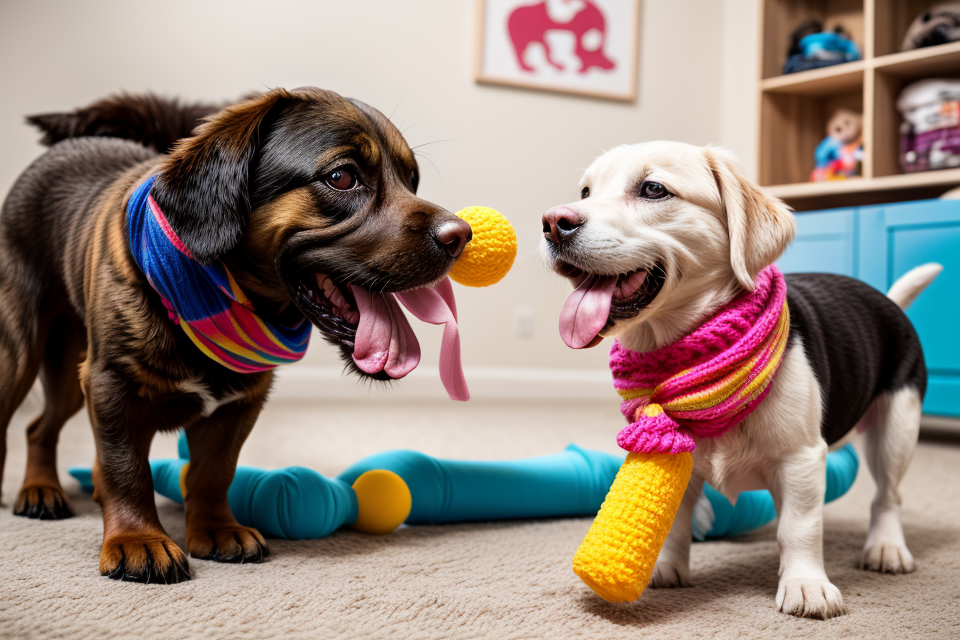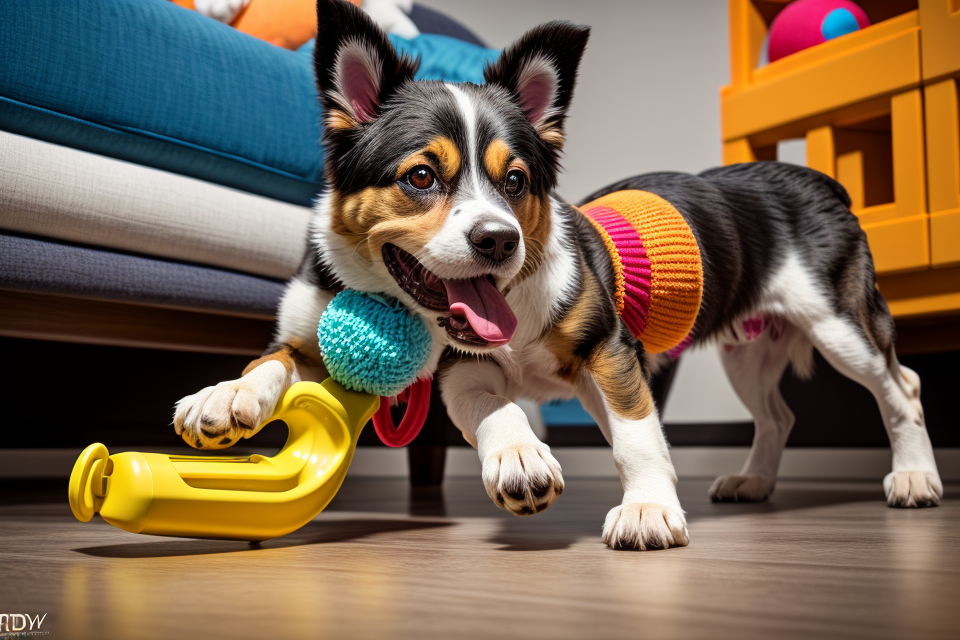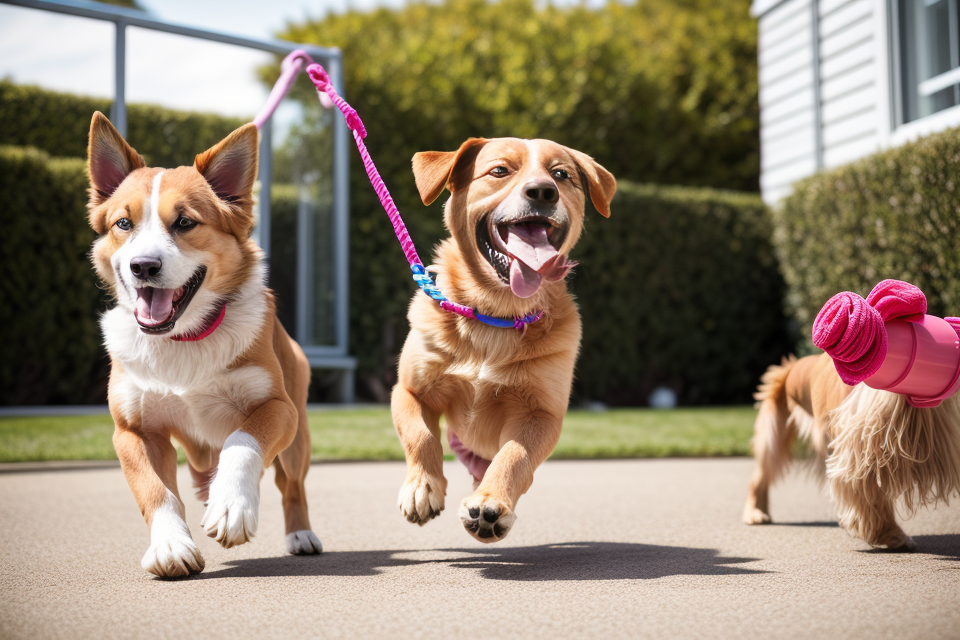Is it safe for dogs to play with tug toys? This is a question that many dog owners ask themselves when they’re looking for new and exciting ways to play with their furry friends. Tug toys are a popular choice among dogs and their owners, but there are some concerns about whether they can be safe for dogs to play with. In this article, we’ll explore the pros and cons of tug toys and provide some tips on how to ensure your dog has a safe and enjoyable experience while playing with them. So, whether you’re a seasoned dog owner or a new pet parent, read on to find out more about the safety of tug toys for dogs.
Yes, it is generally safe for dogs to play with tug toys. Tug toys are a great way to provide mental stimulation and physical exercise for dogs. However, it is important to ensure that the tug toy is appropriately sized for your dog and that it is not made of materials that could be harmful if ingested. Additionally, it is important to supervise your dog while they are playing with the tug toy to prevent any accidents or injuries.
Understanding Tug Toys
What are tug toys?
Tug toys are a type of interactive dog toy that are designed to be played with by dogs and their owners. They are typically made of a durable material such as rope, nylon, or rubber, and are often designed to be easy to grip and hold. Tug toys can come in a variety of shapes and sizes, ranging from small and lightweight to large and heavy.
There are several different types of tug toys available, including:
- Flat tug toys: These are typically rectangular or square in shape and are designed to be easy for dogs to pick up and carry.
- Rope tug toys: These are made of a rope or cord material and are often designed to be tugged back and forth between the dog and the owner.
- Plush tug toys: These are typically made of a soft, plush material and are often designed to be chewed on or carried around by the dog.
- Floating tug toys: These are designed to be played with in water and are often made of a lightweight, buoyant material.
Overall, tug toys are a popular and engaging type of dog toy that can provide hours of fun and exercise for dogs and their owners.
How do tug toys benefit dogs?
Dogs are naturally playful creatures, and they enjoy engaging in various activities that help them stay active and mentally stimulated. Tug toys are a popular choice among dog owners, as they provide numerous benefits for dogs, both physically and mentally.
Physical benefits
Tug toys can help dogs maintain a healthy weight, as they provide a fun and engaging way to exercise their muscles. Playing tug with a toy can help improve a dog’s overall physical fitness, as it requires them to use their strength, agility, and endurance. Additionally, tug toys can help reduce the risk of boredom-related behaviors, such as chewing and digging, which can be harmful to a dog’s health.
Mental benefits
Tug toys also provide mental stimulation for dogs, which is essential for their overall well-being. Playing tug with a toy can help improve a dog’s problem-solving skills, as they need to figure out how to retrieve and hold onto the toy. It can also help improve their memory and cognitive abilities, as they need to remember the location of the toy and the rules of the game.
Moreover, tug toys can help reduce stress and anxiety in dogs, as playing with a toy can provide a sense of comfort and security. It can also help improve a dog’s social skills, as they can learn to share and take turns with other dogs while playing tug.
Overall, tug toys are a fun and beneficial way for dogs to stay active and mentally stimulated. However, it is important to ensure that the toy is safe and appropriate for the dog’s size and strength, and that they are supervised during playtime to prevent any accidents or injuries.
Are tug toys appropriate for all dogs?
Tug toys are a popular choice among dog owners as they are a fun and engaging way to play with your furry friend. However, not all dogs are suitable for playing with tug toys. In this section, we will discuss the factors to consider when determining if tug toys are appropriate for your dog.
Factors to Consider
- Age: Puppies, especially those under six months old, may not be ready for tug toys as their teeth and jaws are still developing. It is important to consult with a veterinarian to determine the appropriate age for your dog to start playing with tug toys.
- Size: Smaller dogs may have difficulty handling larger tug toys, which can lead to choking or injury. It is important to choose a tug toy that is appropriate for your dog’s size.
- Play Style: Some dogs may become overly excited during playtime and may not understand how to properly handle a tug toy. If your dog becomes aggressive or agitated during playtime, it may be best to avoid tug toys altogether.
Breeds to Avoid
Certain breeds may be more prone to health issues, such as joint problems or breathing difficulties, and may not be suitable for playing with tug toys. Some of these breeds include:
- Bulldogs: Due to their short snouts, bulldogs may have difficulty breathing while playing with tug toys.
- Chihuahuas: Chihuahuas may become overly excited during playtime and may injure themselves or others.
- Pugs: Pugs may have difficulty handling tug toys due to their short snouts and legs.
In conclusion, while tug toys can be a fun and engaging way to play with your dog, it is important to consider their age, size, and play style, as well as any underlying health issues, before introducing them to tug toys.
Pros and Cons of Tug Toys
Benefits of tug toys
- Enhances physical strength and agility: Tug toys provide an excellent form of exercise for dogs. Playing tug with a toy requires a dog to use their jaw strength, which helps build muscle in the face, neck, and shoulders. Additionally, it can help improve a dog’s endurance, balance, and coordination.
- Improves mental stimulation: Playing with tug toys can help keep a dog mentally stimulated, which is important for preventing boredom and destructive behavior. Tug toys can be used to teach obedience commands, such as “fetch” or “drop it,” and can also be used in training sessions to reward good behavior.
- Strengthens the bond between dog and owner: Playing tug with a toy can be a fun and interactive way for a dog and owner to bond. It allows for positive reinforcement and interaction, which can help strengthen the bond between the two. Additionally, it can be a great way for owners to observe their dog’s behavior and personality, which can help them better understand their pet’s needs and preferences.
Drawbacks of tug toys
Tug toys are a popular choice among dog owners, as they provide hours of entertainment and exercise for their pets. However, there are several drawbacks to consider before allowing your dog to play with tug toys.
One of the main concerns with tug toys is the risk of teeth and gum injuries. Dogs have strong jaws and teeth, and they may accidentally bite down too hard on the toy, causing injuries to their mouth and gums. This is especially true for dogs with aggressive play styles or a history of dental issues.
Another potential drawback of tug toys is the possibility of aggression during play. Dogs can become highly territorial when playing with their toys, and they may growl, snap, or bite if they feel threatened. This can be especially dangerous if there are other dogs or people nearby.
Finally, tug toys are also at risk of being destroyed by your dog. Dogs have a natural instinct to chew and tear, and they may quickly reduce the tug toy to shreds. This can be frustrating for both you and your dog, and it may also lead to the loss of the toy.
It is important to weigh these drawbacks against the benefits of tug toys before deciding whether or not to allow your dog to play with them. By understanding the potential risks and taking steps to mitigate them, you can help ensure that your dog has a safe and enjoyable experience with tug toys.
Safe Use of Tug Toys
Choosing the right tug toy
When it comes to choosing the right tug toy for your dog, there are several considerations to keep in mind. Here are some tips to help you make the best choice:
- Material and size: The material and size of the tug toy are important factors to consider. Look for toys made from durable materials that can withstand the chewing and biting of your dog. It’s also important to choose a size that is appropriate for your dog’s mouth.
- Recommended brands and models: There are many brands and models of tug toys available on the market. Some popular options include rope toys, rubber toys, and plush toys. Look for toys that have received positive reviews from other dog owners and are made by reputable brands.
When choosing a tug toy for your dog, it’s important to consider their size, strength, and chewing habits. For example, if your dog is a strong chewer, you may want to choose a toy made from a more durable material like nylon or rubber. If your dog is smaller or older, you may want to choose a toy that is easier for them to handle.
Additionally, consider the type of play your dog enjoys. If they like to play tug-of-war, look for a toy that is designed for that purpose. If they prefer to mouth and carry their toys around, a plush toy may be a better option.
In summary, when choosing a tug toy for your dog, consider their size, strength, chewing habits, and play preferences. Look for toys made from durable materials and choose brands and models that have received positive reviews from other dog owners.
Supervising playtime
Playtime with tug toys can be a fun and enjoyable activity for dogs, but it is important to supervise their play to ensure their safety. Here are some tips for supervising playtime with tug toys:
- Ensuring safety during play: Make sure that the tug toy is appropriately sized for your dog and that it is not too small or too large for them to handle. Check the toy for any loose parts or sharp edges that could potentially harm your dog.
- Signs of excessive play: Pay attention to your dog’s behavior during playtime. If they become too aggressive or possessive of the toy, it may be time to take a break or switch to a different type of toy. Signs of excessive play may also include whining, barking, or biting at the toy.
- Taking breaks: It is important to take breaks during playtime to give your dog a chance to rest and recover. If they seem tired or overwhelmed, take the toy away and give them a chance to relax.
- Monitoring for signs of injury: Watch your dog during playtime for any signs of injury, such as dropping the toy or showing signs of pain. If you notice any of these signs, stop playtime immediately and assess your dog for any potential injuries.
By following these tips, you can help ensure that your dog has a safe and enjoyable experience playing with tug toys.
Introducing tug toys gradually
Introducing tug toys gradually is an essential aspect of ensuring the safety of your dog while playing with tug toys. This process involves starting with non-toxic toys and gradually building up to harder toys as your dog becomes more comfortable and experienced with playing tug.
Starting with a non-toxic toy
It is crucial to start with a non-toxic toy when introducing tug toys to your dog. This is because some dogs may chew on the toy and ingest small parts, which can be harmful if the toy contains harmful chemicals or materials. To ensure the safety of your dog, it is advisable to use a toy made from natural materials such as rubber, rope, or fabric.
Building up to harder toys
After your dog has become comfortable with playing tug with a non-toxic toy, you can gradually introduce harder toys such as plush toys or toys with squeakers. It is essential to monitor your dog’s behavior while playing with these toys to ensure that they are not causing any harm. If your dog seems uncomfortable or shows signs of distress, it is best to stop playing and switch to a different toy.
By introducing tug toys gradually, you can ensure that your dog becomes comfortable with playing tug and enjoys the activity without any risks or harm.
Alternatives to Tug Toys
Other types of dog toys
When it comes to choosing toys for your furry friend, there are plenty of options beyond tug toys. Here are some other types of dog toys that can provide your pet with hours of entertainment and enjoyment:
- Rope toys: Rope toys are a classic choice for dogs. They are durable, long-lasting, and can be easily stuffed with treats or peanut butter for added incentive. Rope toys come in a variety of sizes and colors, making them suitable for dogs of all ages and sizes.
- Plush toys: Plush toys are a great option for dogs who love to cuddle and snuggle. They come in a variety of shapes and sizes, from small stuffed animals to large plush pillows. Plush toys can be filled with catnip or other treats to make them even more appealing to your pet.
- Interactive toys: Interactive toys are designed to challenge your dog’s mind and body. They come in a variety of shapes and sizes, from puzzle toys that require your dog to figure out how to get a treat, to toys that dispense treats based on your dog’s movements. Interactive toys are a great way to keep your dog mentally stimulated and physically active.
When choosing dog toys, it’s important to consider your pet’s preferences and needs. While tug toys can be a fun and engaging option, there are plenty of other types of dog toys that can provide your pet with endless entertainment and joy.
Physical activities
Walking and hiking:
Walking and hiking are excellent physical activities for dogs. These activities provide exercise, mental stimulation, and an opportunity for dogs to explore new environments. Walking and hiking with a dog can help build stronger bonds between the dog and the owner, and it also provides a chance for dogs to socialize with other dogs they may encounter on the trail.
Swimming:
Swimming is another great physical activity for dogs. Swimming is low-impact exercise that can be beneficial for dogs of all ages and sizes. Swimming can help strengthen a dog’s muscles, improve cardiovascular health, and provide mental stimulation. Dogs that enjoy swimming can participate in activities such as dog paddleboarding, dog surfing, and even dog diving.
Playing fetch:
Playing fetch is a classic physical activity for dogs. It is a simple and easy game that can be played in any location, indoors or outdoors. Playing fetch provides exercise and mental stimulation for dogs, and it is also a great way to bond with your dog. It is important to use a soft and safe fetch toy, such as a tennis ball or a plush toy, to prevent injury to your dog’s mouth.
Mental activities
Dogs are intelligent creatures that thrive on mental stimulation. Engaging them in activities that challenge their minds can be just as important as physical exercise. Here are some mental activities that dog owners can try with their pets:
Training sessions
Training sessions are an excellent way to keep dogs mentally stimulated and engaged. Teaching dogs new tricks and commands not only strengthens the bond between the dog and owner but also provides mental stimulation for the dog. Simple tricks such as “sit,” “stay,” and “roll over” can be taught to puppies and older dogs alike. More complex tricks such as “shake” and “high five” can also be taught to dogs that have already mastered the basics.
Scavenger hunts
Scavenger hunts are another fun and engaging activity for dogs. Hiding treats or toys around the house or yard and having the dog find them can be a great way to keep dogs mentally stimulated. This activity can be made more challenging by hiding the treats or toys in more difficult-to-find locations.
Obedience challenges
Obedience challenges can also be a great way to mentally stimulate dogs. These challenges can include activities such as agility courses, which require dogs to navigate through tunnels, jumps, and obstacles. Other obedience challenges can include search and rescue missions, where dogs are trained to locate specific items, or tracking, where dogs are trained to follow a scent.
These mental activities are not only a great way to keep dogs mentally stimulated but also provide a bonding experience for the dog and owner. Engaging in these activities on a regular basis can help prevent boredom and destructive behavior in dogs.
FAQs
1. What are tug toys?
Tug toys are a type of dog toy that are designed to be played with by dogs and their owners. They are typically made of rope, fabric, or other materials that are strong enough to withstand the teeth and jaws of dogs. Tug toys are often used in games of tug-of-war between dogs and their owners, and they can be a fun and engaging way to play with your dog.
2. Are tug toys safe for dogs?
In general, tug toys are considered to be safe for dogs. They are designed to be durable and can withstand the chewing and biting of dogs, and they do not contain any small parts that could be swallowed or harmful materials that could harm your dog. However, it is important to supervise your dog when they are playing with a tug toy, as with any toy, to ensure that they are not accidentally swallowing or choking on any pieces of the toy.
3. Can tug toys be harmful to dogs?
While tug toys are generally safe for dogs, there are some potential risks associated with them. If your dog is not used to playing with tug toys, they may be more likely to swallow pieces of the toy if they accidentally break it off while playing. Additionally, if your dog is very enthusiastic about playing with a tug toy, they may become very excited and potentially aggressive, which could lead to accidental biting or other behavioral issues. It is important to supervise your dog when they are playing with a tug toy and to make sure that they are not engaging in any behaviors that could be harmful to them.
4. How do I choose the right tug toy for my dog?
When choosing a tug toy for your dog, it is important to consider their size, strength, and play style. If your dog is small or elderly, you may want to choose a smaller or softer tug toy that is easier for them to handle. If your dog is larger or more energetic, you may want to choose a larger or sturdier tug toy that can withstand more aggressive play. It is also a good idea to choose a tug toy that is made from materials that are safe for dogs, such as rope or fabric, and to avoid any toys that contain small parts or other materials that could be harmful to your dog.



